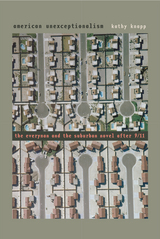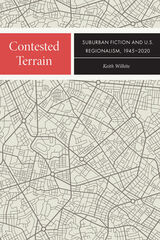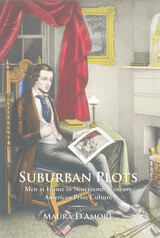3 books about Suburban life in literature

American Unexceptionalism
The Everyman and the Suburban Novel after 9/11
Kathy Knapp
University of Iowa Press, 2014
American Unexceptionalism examines a constellation of post-9/11 novels that revolve around white middle-class male suburbanites, thus following a tradition established by writers such as John Updike and John Cheever. Focusing closely on recent works by Richard Ford, Chang-Rae Lee, Jonathan Franzen, Philip Roth, Anne Tyler, Gish Jen, A. M. Homes, and others, Kathy Knapp demonstrates that these authors revisit this well-trod turf and revive the familiar everyman character in order to reconsider and reshape American middle-class experience in the wake of the 9/11 attacks and their ongoing aftermath.
The novels in question all take place in the sprawling terrain that stretches out beyond the Twin Towers—the postwar suburbs that since the end of World War II have served, like the Twin Towers themselves, as a powerful advertisement of dominance to people around the globe, by projecting an image of prosperity and family values. These suburban tales and their everyman protagonists grapple, however indirectly, with the implications of the apparent decline of the economic, geopolitical, and moral authority of the United States. In the context of perceived decay and diminishing influence, these novels actively counteract the narrative of American exceptionalism frequently peddled in the wake of 9/11.
If suburban fiction has historically been faulted for its limited vision, this newest iteration has developed a depth of field that self-consciously folds the personal into the political, encompasses the have-nots along with the haves, and takes in the past when it imagines the future, all in order to forge a community of readers who are now accountable to the larger world. American Unexceptionalism traces the trajectory by which recent suburban fiction overturns the values of individualism, private property ownership, and competition that originally provided its foundation. In doing so, the novels examined here offer readers new and flexible ways to imagine being and belonging in a setting no longer characterized by stasis, but by flux.
The novels in question all take place in the sprawling terrain that stretches out beyond the Twin Towers—the postwar suburbs that since the end of World War II have served, like the Twin Towers themselves, as a powerful advertisement of dominance to people around the globe, by projecting an image of prosperity and family values. These suburban tales and their everyman protagonists grapple, however indirectly, with the implications of the apparent decline of the economic, geopolitical, and moral authority of the United States. In the context of perceived decay and diminishing influence, these novels actively counteract the narrative of American exceptionalism frequently peddled in the wake of 9/11.
If suburban fiction has historically been faulted for its limited vision, this newest iteration has developed a depth of field that self-consciously folds the personal into the political, encompasses the have-nots along with the haves, and takes in the past when it imagines the future, all in order to forge a community of readers who are now accountable to the larger world. American Unexceptionalism traces the trajectory by which recent suburban fiction overturns the values of individualism, private property ownership, and competition that originally provided its foundation. In doing so, the novels examined here offer readers new and flexible ways to imagine being and belonging in a setting no longer characterized by stasis, but by flux.
[more]

Contested Terrain
Suburban Fiction and U.S. Regionalism, 1945-2020
Keith Wilhite
University of Iowa Press, 2022
Contested Terrain explores suburban literature between two moments of domestic crisis: the housing shortage that gave rise to the modern era of suburbanization after World War II, and the mortgage defaults and housing foreclosures that precipitated the Great Recession. Moving away from scholarship that highlights the alienating, placeless quality of suburbia, Wilhite argues that we should reimagine suburban literature as part of a long literary tradition of U.S. regional writing that connects the isolation and exclusivity of the domestic realm to the expansionist ideologies of U.S. nationalism and the environmental imperialism of urban sprawl. Wilhite produces new, unexpected readings of works by Sinclair Lewis, Lorraine Hansberry, Richard Yates, Patricia Highsmith, Don DeLillo, Jonathan Franzen, Jeffrey Eugenides, Chang-rae Lee, Richard Ford, Jung Yun, and Patrick Flanery. Contested Terrain demonstrates how postwar suburban nation-building ushered in an informal geography that recalibrated notions of national identity, democratic citizenship, and domestic security to the scale of the single-family home.
[more]

Suburban Plots
Men at Home in Nineteenth-Century American Print Culture
Maura D'Amore
University of Massachusetts Press, 2014
In the middle of the nineteenth century, as Americans contended with rapid industrial and technological change, readers relied on periodicals and books for information about their changing world. Within this print culture, a host of writers, editors, architects, and reformers urged men to commute to and from their jobs in the city, which was commonly associated with overcrowding, disease, and expense. Through a range of materials, from pattern books to novels and a variety of periodicals, men were told of the restorative effects on body and soul of the natural environment, found in the emerging suburbs outside cities such as New York, Boston, and Philadelphia. They were assured that the promise of an ideal home, despite its association with women's work, could help to motivate them to engage in the labor and commute that took them away from it each day.
In Suburban Plots, Maura D'Amore explores how Henry David Thoreau, Henry Ward Beecher, Donald Grant Mitchell, Nathaniel Hawthorne, Nathaniel Parker Willis, and others utilized the pen to plot opportunities for a new sort of male agency grounded, literarily and spatially, in a suburbanized domestic landscape. D'Amore uncovers surprising narratives that do not fit easily into standard critical accounts of midcentury home life. Taking men out of work spaces and locating them in the domestic sphere, these writers were involved in a complex process of portraying men struggling to fulfill fantasies outside of their professional lives, in newly emerging communities. These representations established the groundwork for popular conceptions of suburban domestic life that remain today.
In Suburban Plots, Maura D'Amore explores how Henry David Thoreau, Henry Ward Beecher, Donald Grant Mitchell, Nathaniel Hawthorne, Nathaniel Parker Willis, and others utilized the pen to plot opportunities for a new sort of male agency grounded, literarily and spatially, in a suburbanized domestic landscape. D'Amore uncovers surprising narratives that do not fit easily into standard critical accounts of midcentury home life. Taking men out of work spaces and locating them in the domestic sphere, these writers were involved in a complex process of portraying men struggling to fulfill fantasies outside of their professional lives, in newly emerging communities. These representations established the groundwork for popular conceptions of suburban domestic life that remain today.
[more]
READERS
Browse our collection.
PUBLISHERS
See BiblioVault's publisher services.
STUDENT SERVICES
Files for college accessibility offices.
UChicago Accessibility Resources
home | accessibility | search | about | contact us
BiblioVault ® 2001 - 2024
The University of Chicago Press









